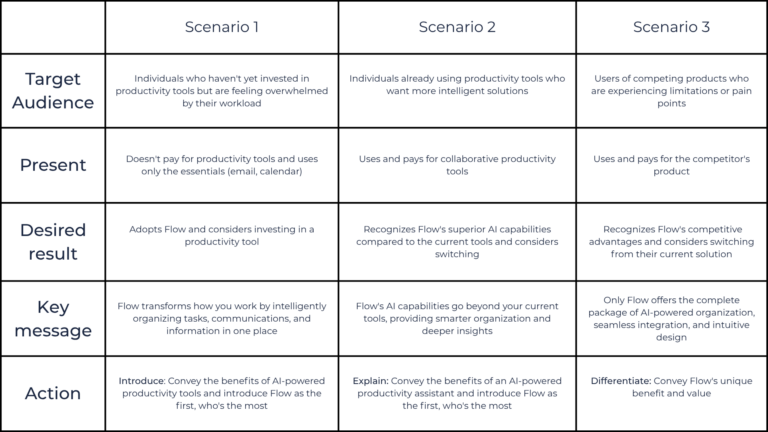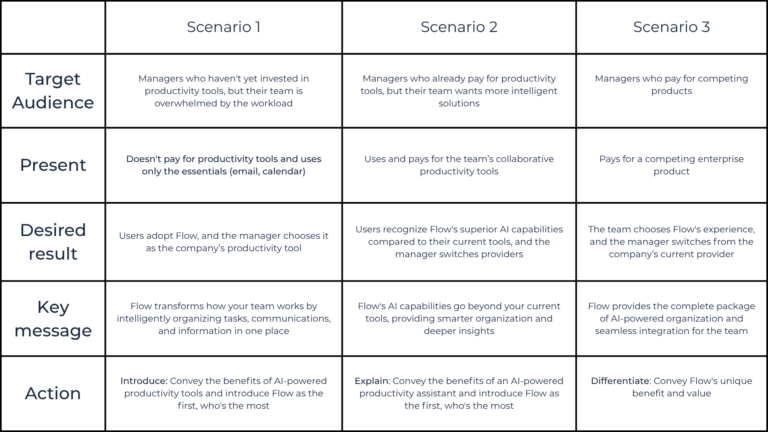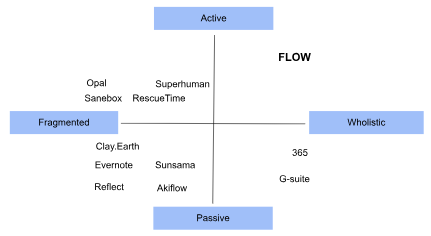Brand strategy, story naming, identity, and messaging for an AI-powered productivity startup
Duration: 10 weeks
Price: $6,000
EnterFlow.co
BACKGROUND
The company’s product premise is that distractions reduce productivity, and there’s no way to avoid them in an information/notification-filled world. The new productivity SaaS product aims to be the antidote to distractions, the gatekeeper of attention, and inducer of focus.
THE
CHALLENGE
AI tools and assistants are popping up like mushrooms after the rain, but without meaningful differentiation, most fade into the background.
THE
OBJECTIVE
Name, position, and develop an authentic and unique brand for an AI startup that specializes in eliminating noise, helping users become more productive.
THE
SCOPE
Brand positioning, strategy, voice, name, identity, messaging, and style guide.
RESEARCH
The main objectives of the research are to understand the market, the project, the product, and the patron.
DISCOVERY
1. Five in-depth interviews with the founder to understand the vision and extract the essence.
2. A dozen interview sessions with potential users to understand their underlying needs, wants, and motivators.
3. SWOT and competitive analysis to identify market gaps and opportunities.
CUSTOMER &
CONSUMER
Audience: A closely knit community (mostly male, 28–45) of knowledge workers, technophiles, and productivity junkies who use advanced workflow, personal productivity, and time management (personal or enterprise) tools to manage their work and personal lives. The Productive Man—a self-coined moniker—happens to the world, not the other way around.
Psychographics: Living the Productive Man (PM) lifestyle, scratches the tech itch, adds excitement during the workday, and provides a topic of conversation at dinner parties. The PM likes to spend time with like-minded PMs in the community. He/she seeks learning and takes risks to get and stay ahead. She’s proud to be accountable and requires as much control as possible in his pursuit of personal exceptionalism. The PM/W believes anyone who resists tech symbiosis is at a disadvantage. Seeing time management and freedom as two sides of the same thing and not subscribing to the work-life balance ethos, he prefers tech integration in exchange for time freedom. Tools being used: GSuite, Microsoft, Slack, Github, Todoist, Asana, Monday, Notion, Craft, Reflect, Clay (or other personal CRM), Sanebox, Opal, RescueTime, Chat GPT, Salesforce, Hubspot, GitHub, Notion (personal and enterprise); Sunsama, Akiflow, and other advanced personal productivity tools.Personality: analytical, practical, and methodical.
Ideals: anything that can be optimized should be.
Interests: tech that makes humans better.
Needs: use multiple tools without getting distracted.
Goals: more tasks but the same amount of time.
Mission: achieve the optimal version of oneself.
Objective: get and stay ahead of peers by using hacks to achieve more with fewer resources.
Challenges: an increasing number of useful but distracting tools designed to consume attention.
Solutions: reclaiming one’s own attention by eliminating distractions.
What he wants: accomplish more without changing the meaning of time.
What he doesn’t want: another complicated tool.
Ideal experience: being able to focus on creative work at will.
Before: the paradox of spending more time on time-saving tools that require more time. (Like the fuel that weighs over 90% of the rocket that it’s fueling.)
After: being able to focus on work and do the best of it in a state of flow.
Target Consumer: Nate
Male, 25–38, sales and CS rep.

Target Customer: Tom
Male, late 35–53, project manager, C-level, CxOs, other managers, and founders.
Journey: Tom noticed people on the team trying and sharing a product that increases their productivity, and after comparing it with existing tools, he purchased Flow licenses for the team.

SWOT
Strengths
Focus on a narrow niche, and the founder’s experience with the subject matter.
Weakness
Not first to the broader market (AI assistants exist).
Opportunities
Develop and lead a niche
with a product that integrates with advanced tools and ensures enterprise data security.
Threats
Low barrier to entry.

BRAND
The delivery included strategic brand components as well as a brand (design, style, and communication) guide.
WHAT'S FLOW
Flow is an empathy-driven, voice-first, rational productivity assistant. She learns from interactions and continuously adjusts herself to the user’s workflow. Her goal is to eliminate mental barriers and help the user achieve flow.
POSITIONING
Flow is the first emotionally intelligent (AI) productivity assistant.
What the product does for me
Removes distractions, saves time, and helps focus.
How the brand makes me look
Sophisticated, effective, and future-thinking.
How the brand makes me feel
Productive, efficient, and in control of my attention and time.
How I describe the product
An assistant that understands my workflow, eliminates distractions, and helps me be more productive.
NAME
The name was inspired by a book, titled Flow: The Psychology of Optimal Experience (by Mihaly Csikszentmihalyi).
The book explores the productive and focused state of mind that people struggle to attain and strive to maintain. Capturing and harnessing the elusive state of flow is the problem the—yet to be named—startup promised to solve.
PURPOSE
Flow’s purpose is to help people reach the near-meditative state of focus and efficiency, aka the state of flow. By managing distractions and optimizing workflows, Flow guides one toward the optimal version of oneself.
TAGLINE
MISSION
Declutter the mind and enrich the world with the fruits of focus.
Flow’s guiding rule for brand, communication, and experience decisions:
Does it contribute to attaining or maintaining Flow?
MESSAGE
Less distraction, more action.
VALUES
1. Lean is better, and simple is supreme
2. Technology helps us become better
3. Less interruption, more action
PRINCIPLES
Innovation, EQ, simplicity.
IDENTITY
Flow the brand / Flow the assistant
Personality
One of the questions posed during customer interviews was how the interviewees addressed Siri and Google Assistant. The overwhelming response was that Siri is a she, and Google is an it. A name and a voice were enough to anthropomorphize an assistant.
But since Flow’s identity plays a major part in its differentiation, I added additional layers to her identity to make it personable and distinct.
Character
A combination of Gwynne Shotwell (a COO who gets things done), Sam from the movie Her (empathy), and Joan from MadMen (an executive assistant who takes care of mundane tasks with authority).
In one word
Noun: intelligence
Adjective: focused
Verb: consolidating
Logo evolution
An Iterative process of refining and adjusting the face to the name
Brand guide (2.0)
Design refinement by Luke Lopez